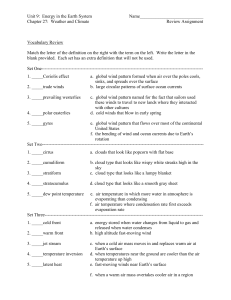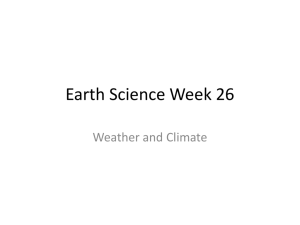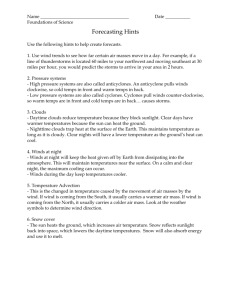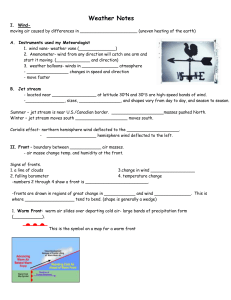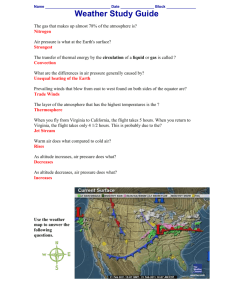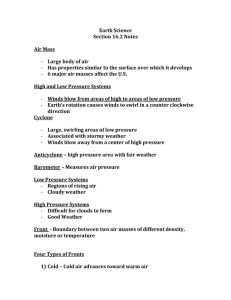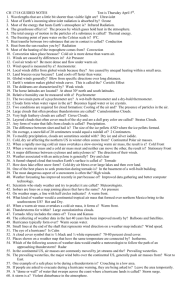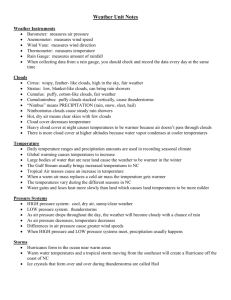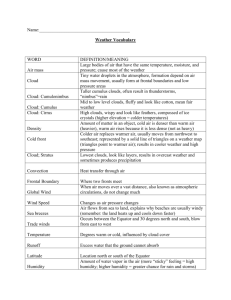click here for weather study guide file
advertisement
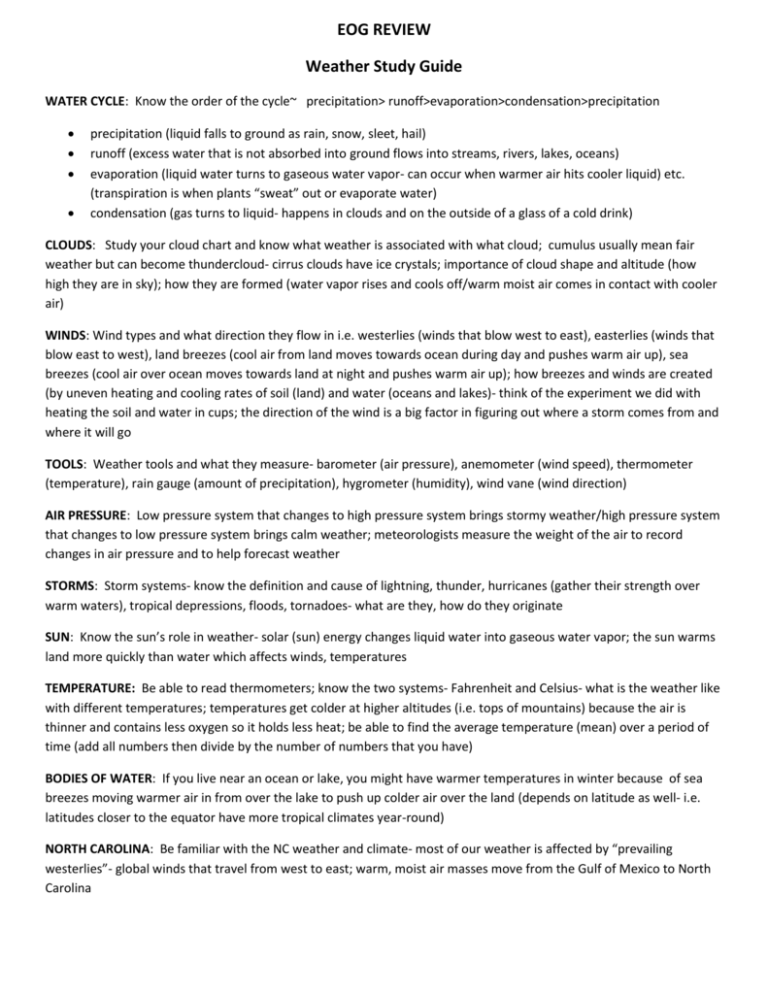
EOG REVIEW Weather Study Guide WATER CYCLE: Know the order of the cycle~ precipitation> runoff>evaporation>condensation>precipitation precipitation (liquid falls to ground as rain, snow, sleet, hail) runoff (excess water that is not absorbed into ground flows into streams, rivers, lakes, oceans) evaporation (liquid water turns to gaseous water vapor- can occur when warmer air hits cooler liquid) etc. (transpiration is when plants “sweat” out or evaporate water) condensation (gas turns to liquid- happens in clouds and on the outside of a glass of a cold drink) CLOUDS: Study your cloud chart and know what weather is associated with what cloud; cumulus usually mean fair weather but can become thundercloud- cirrus clouds have ice crystals; importance of cloud shape and altitude (how high they are in sky); how they are formed (water vapor rises and cools off/warm moist air comes in contact with cooler air) WINDS: Wind types and what direction they flow in i.e. westerlies (winds that blow west to east), easterlies (winds that blow east to west), land breezes (cool air from land moves towards ocean during day and pushes warm air up), sea breezes (cool air over ocean moves towards land at night and pushes warm air up); how breezes and winds are created (by uneven heating and cooling rates of soil (land) and water (oceans and lakes)- think of the experiment we did with heating the soil and water in cups; the direction of the wind is a big factor in figuring out where a storm comes from and where it will go TOOLS: Weather tools and what they measure- barometer (air pressure), anemometer (wind speed), thermometer (temperature), rain gauge (amount of precipitation), hygrometer (humidity), wind vane (wind direction) AIR PRESSURE: Low pressure system that changes to high pressure system brings stormy weather/high pressure system that changes to low pressure system brings calm weather; meteorologists measure the weight of the air to record changes in air pressure and to help forecast weather STORMS: Storm systems- know the definition and cause of lightning, thunder, hurricanes (gather their strength over warm waters), tropical depressions, floods, tornadoes- what are they, how do they originate SUN: Know the sun’s role in weather- solar (sun) energy changes liquid water into gaseous water vapor; the sun warms land more quickly than water which affects winds, temperatures TEMPERATURE: Be able to read thermometers; know the two systems- Fahrenheit and Celsius- what is the weather like with different temperatures; temperatures get colder at higher altitudes (i.e. tops of mountains) because the air is thinner and contains less oxygen so it holds less heat; be able to find the average temperature (mean) over a period of time (add all numbers then divide by the number of numbers that you have) BODIES OF WATER: If you live near an ocean or lake, you might have warmer temperatures in winter because of sea breezes moving warmer air in from over the lake to push up colder air over the land (depends on latitude as well- i.e. latitudes closer to the equator have more tropical climates year-round) NORTH CAROLINA: Be familiar with the NC weather and climate- most of our weather is affected by “prevailing westerlies”- global winds that travel from west to east; warm, moist air masses move from the Gulf of Mexico to North Carolina You should… Be able to identify each process in the water cycle Know what each weather instrument is used to measure Know the types of clouds and the weather associated with them Know the differences between a sea breeze and a land breeze Know the differences between the characteristics of high pressure areas/systems and low pressure areas/systems Be able to describe the weather for areas located near large bodies of water Know what direction weather systems usually move in the United States Know the difference between longitude and latitude Be able to describe the characteristics of each climate zone (polar, temperate, tropical) Know what a jet stream is Know the differences between a cold front and a warm front Know the characteristics of types of severe weather Know the affects of rising or falling barometric pressure (air pressure) on temperature, humidity, weather Be able to determine cloud cover, wind speed, and wind direction when shown a picture of a wind barb Be able to distinguish between the symbol used to represent a warm front and the symbol used to represent a cold front on a weather map Know the differences between thermal energy being transferred by convection, conduction, and radiation
